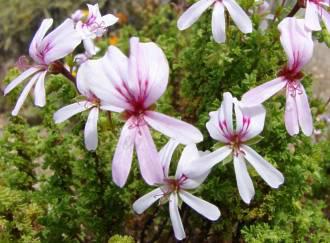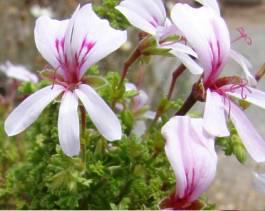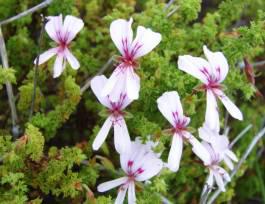Pelargonium crispum
Pelargonium crispum (P.J.Bergius) L'Hér.
Family: Geraniaceae
Common names: lemon-scented pelargonium, crisped-leaf pelargonium
Introduction
Pelargonium crispum is ideal for any garden as it produces pretty pink flowers for most of the year.

Description
Description
Pelargonium crispum is an erect, much-branched shrub that grows up to 700 mm tall. The young stems are soft and green and become woody when older. The leaves are lemon-scented, fan-shaped and the leaf margins are crisped. The leaves are distichous, meaning that they are arranged one above the other in two opposite rows. The flowers are single or in clusters of 2 or 3 and are borne on short peduncles. They are white to dark pink, about 25 mm in diameter, the flower tube about 5-8 mm long. It flowers from August to April with a peak in September and October.

Conservation Status
Status
Pelargonium crispum is very common and has no recorded conservation status.
Distribution and habitat
Distribution description
Pelargonium crispum occurs from Worcester to Bredasdorp in the Western Cape Province. The plants are largely associated with rocky lower mountain or hill slopes within the south-western Western Cape, growing in the shelter of boulders in sandy soils.
Derivation of name and historical aspects
History
The genus Pelargonium derives its name from the beak of a stork, pelargos in Greek. The shape of the fruit resembles the beak of that bird. The specific name crispum refers to the crisped leaves. The genusPelargonium belongs to the family Geraniaceae, consisting of 11 genera and 800 species in the subtropical and tropical world. There are about 219 species in southern Africa.
Ecology
Ecology
The seeds are elliptically shaped, and attached to them is a feathered, tail-like structure that coils when the seed is released. The tail enables the seed to drill into and secure itself in the soil if twisted around by the wind or affected by the movement of animals.
Uses
Use
No cultural uses have been recorded. Leaves and young shoots can be used for essential oils. Leaves can also be dried and used in a potpourri.
Growing Pelargonium crispum
Grow
Pelargonium crispum is ideal for any garden as it flowers for most of the year and can withstand extreme temperatures.

It can be grown from seed and cuttings. Sow seeds in autumn. Fill seed trays with a light, well-drained potting soil. Spread the seeds evenly on top of the soil. Cover seeds with a thin layer of white sand. Water thoroughly with watering can with a fine spray. Place trays in a lightly shaded area. Germination usually takes place within 4 weeks. Pelargoniums grown from seed are generally more vigorous than those grown from cuttings. Transplant seedlings into the garden or in pots. The plant can grow easily in a garden with damp to moist soils in full sun.
Cuttings can be grown at any time of the year. Take young stem cuttings 150 mm long and apply a rooting hormone to stimulate the rooting process. Insert them into prepared holes and place in a cold frame to root. Rooting usually takes about 3-4 weeks. Once the cuttings have rooted, pot them in a well-drained potting soil mix. Feed the newly rooted cuttings with a liquid seaweed-based fertilizer.
References
- Goldblatt, P. & Manning, J.C. 2000. Cape plants. A conspectus of the Cape flora of
- South Africa. Strelitzia 9. National Botanical Institute, Pretoria and Missouri Botanical Garden Press.
- Van der Walt, J.J.A. & Vorster, P.J. 1988. Pelargoniums of southern Africa, vol. 3. Kirstenbosch National Botanical Gardens, Cape Town.
Credits
Olivia Tyambetyu
Millennium Seed Bank Project
Kirstenbosch National Botanical Garden
June 2011
Plant Attributes:
Plant Type: Perennial, Shrub
SA Distribution: Western Cape
Soil type: Sandy, Loam
Flowering season: Spring, Early Summer, Late Summer
PH: Neutral
Flower colour: White, Pink
Aspect: Full Sun, Morning Sun (Semi Shade), Afternoon Sun (Semi Shade)
Gardening skill: Easy
Special Features:
Horticultural zones







Rate this article
Article well written and informative
Rate this plant
Is this an interesting plant?
Login to add your Comment
Back to topNot registered yet? Click here to register.